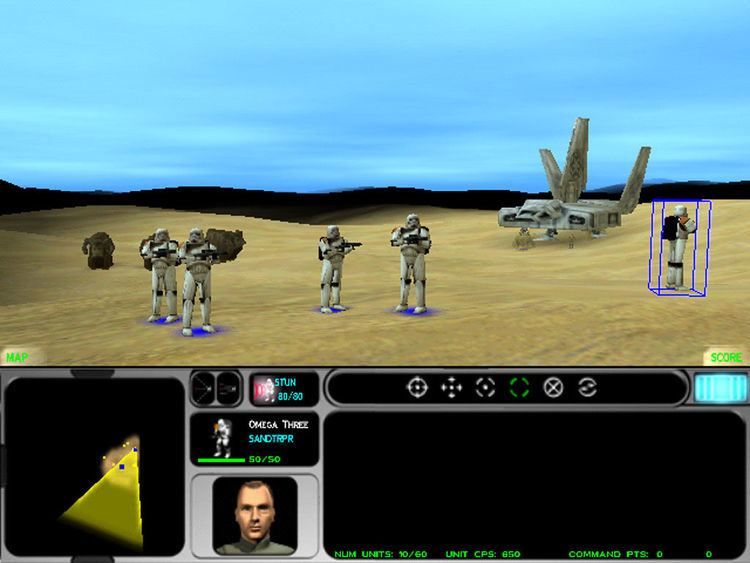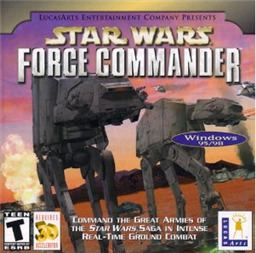Artist(s) Garry M. Gaber Designer Garry M. Gaber | Programmer(s) Edward Kilham Writer(s) Garry M. Gaber Initial release date 2000 Publisher LucasArts | |
 | ||
Developers LucasArts, Ronin Entertainment Similar LucasArts games, Real-time strategy games | ||
Star wars force commander intro
Star Wars: Force Commander is a real-time strategy video game released for the Microsoft Windows platform on March 21, 2000. It was co-developed by Ronin Entertainment and LucasArts, and published by LucasArts.
Contents
- Star wars force commander intro
- Star wars force commander mission 6 part 1 of 2 cold vengence
- Gameplay
- Plot
- Development
- Reception
- References

Star wars force commander mission 6 part 1 of 2 cold vengence
Gameplay

Star Wars: Force Commander is a real-time strategy video game. The player commands forces as though they are the commander rather than an infantry unit. The game utilizes a birds-eye view around a 3D map. The levels are largely plot-focused, with initial levels playing as the Imperial faction against the Rebellion, whilst as the plot progresses and the character defects to the Rebellion, players then fight against the Imperials. Levels are ground assault based, as the game lacks space combat. Outsides of the main story-mode Campaign, scenarios can be re-played under the Scenario option, and players can set up their own battles in the Skirmish mode where up to four sides can compete against one another, though they only have the faction choice of Imperials or the Rebellion.
The game also features a few options to connect with other players via multiplayer. Up to six players can join together, and Local area network (LAN) and TCP/IP connections are supported. Historically the game was supported via the Microsoft Gaming Zone, however Zone services have since been shut down. LAN gameplay is limited to two players. The game's campaign is not available in multiplayer. Instead an instant action mode is used. Players can choose any combination of teams or work together to challenge the AI computer player.
Plot
The game interweaves its story through the events of Episodes IV through VI, sometimes intersecting with known Star Wars events, while telling an original Star Wars story. It is shown from the point of view of a young officer in the Imperial Navy, Brenn Tantor, who begins as a stormtrooper, but soon enough is given his own command. The first task (from the training missions) is to search for an escape pod that landed on Tatooine, and then track the droids that were inside - which is a reference to the opening scenes of Star Wars Episode IV when C-3PO and R2-D2 escape Imperial clutches via an escape pod which crashes on Tatooine.
The main character is loyal to the Empire for the first half of the game, until his brother, Dellis Tantor discovers that the Empire killed their father. Dellis is imprisoned by the Empire for revealing this information, though Brenn is initially led to believe that Dellis has been killed. Brenn defects to the Rebel Alliance and proceeds to fight his former commanders. As well as the Tatooine training missions, the player participates in the Battle of Hoth (from the Imperial point of view) and the Battle of Endor (as a Rebel). The game ends with the battle to capture the Imperial Palace on Coruscant, and ultimately the liberation of Dellis.
Development
Originally conceived as a 2D strategy game, LucasArts scrapped the overall design after its first public viewing at E3 1998. LucasArts decided instead to use an optimized version of a 3D engine supplied by Ronin Entertainment. The title was jointly developed by LucasArts and Ronin Entertainment, using Ronin's programmers and engine partnered with LucasArts' project leadership, designers, and artists.
The latest and last patch for the game is version 1.1 released in March, 2000. One feature of note in Force Commander is its music, which consists of remixes of John Williams' original Star Wars scores, done by Peter McConnell. Over 3,500 voice lines were recorded for the game.
Reception
Star Wars: Force Commander was met with very mixed reception. Gaming Age gave a largely positive review, stating that 'Force Commander lives up to the hype and is a game that deserves a chunk of your precious hard drive space'. Later the review relates that 'the graphics in Force Commander are excellent'. Greg Kasavin of GameSpot gave the game a 6 out of 10. He cited dated graphics, ineffective controls, and flawed gameplay as reason the game "falls short of its ambitious intent." Kasavin conceded the game "has some good ideas. Its campaign has an involving plot and interesting mission objectives", and praised the 3D mission briefings.
Mark Hill of PC Zone gave it an 81%. Michael Lafferty of GameZone gave it an 8 out of 10. Electric Playground gave it a 7 out of 10. Nick Woods of AllGame gave it three stars out of five. Sarju Shah of Firing Squad gave it a 60%. Tal Blevins of IGN gave it a score of 4.7 out of 10. In a feature on the history of Star Wars games, IGN's Rus McLaughlin called Force Commander "a blocky, buggy, undiluted failure". A similar article in GMR Magazine from March 2004 listed Force Commander as the worst Star Wars game. In the book Rogue Leaders: The Story of LucasArts, author Rob Smith said the "dated-looking visuals and clumsy controls turned off strategy gamers." Hollywood.com placed it fifth in a list of worst Star Wars video games. Rock, Paper, Shotgun's Alec Meer was also highly critical of the game. "I didn’t make it past the first few levels. It was miserable."
